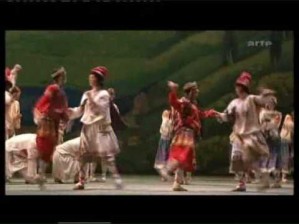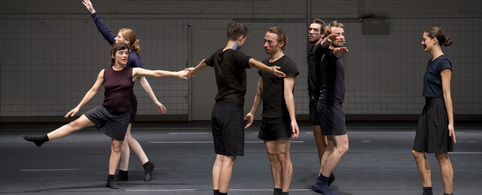
| The piece I am writing here about is with a history, one that had created a big turmoil when first performed. It is in itself a disturbing piece about the renewal and |  |
| sacrifice of energies – “the mystery and great surge of the creative power of Spring†as Strawinsky defined it: Le Sacre Du Printemps. Today the renewed performance of Laurent Chétouane has been sacrificied to the title ‘Sacré Sacre du Printemps’.
Sometimes it might quite be helpful to come from another field. It creates a distance, a not-knowing that comes without the expectations the insider has. Certainly it as well has its disadvantages especially in regards of deciphering all the tiny connoted gestures. But still it allows generally a view from a different angle – access or non-access by other means. And to a certain extent that even describes the theme of the work. It enables for example Andrew Wass in his blog to rightfully question Laurent Détouane’s remark: “Dance is no longer representation.” by countering that “dance hasn’t been representation for decades. Did he not get the Judson/Trio A/Merce/Brown memo?†I could follow up in a similar way and ask, is Détouane that less interested in dance and all its related movement forms that he is not familiar with Deborah Hay and her piece No time to fly? How can he without bringing some references speak that bland about his intentions of forcing the dancer’s body to describe a situation without getting absorbed/doomed in it as a unique idea? But I want to go back and see what fascinated me nevertheless in seeing one time more the borders a bit further moved, as it is anyway happening all the time in these recent years in the ‘intertwining’ of the fields of performing arts and artistic performance. That it is claimed to happen as the big ‘new’ development without referring to any predecessor might be the most annoying point, and can only be explained that it is looked at from a very ‘theater’ related point of view. One then that also provokes just the critiques it gets form an audience that has certain expectations and now sees itself confronted with critiques like ‘Zombie-Yoga’. Even though views like these aren’t even aware of the huge marker this piece sets up, and their complain that an icon of modernity has been ‘sacrificied’ only lays bare their expectations of a certain expressionism and narrative by average connected to the piece’s modernity. In fact the work, music and as well the choreography, became known as for disturbing the expectations, and the mark it set, was one of an uproar – the break-up into modernity was quite painful at its very time. In today’s version we are confronted with seven dancers, dressed in some last century gym-like outfit, who start their movements through measurements. Their looks, their gestures, their moves, all begin with an exploration of space. The space they have, the space inbetween them, the space to cross and to structure. Obvious is their distance, their way of touching without direct contact. Their biggest concern seems to be the rediscovery of the body in space, and that this space has to be defined through the finding of unknown, or unusual gestures, which nevertheless bare strains of their knowledge, as well as gestures from the past. In fact some references incorporated here almost literally traces of the original and are that striking ones, so that one wonders, why there is so much complain of the individual ‘archaic’ face paint of each of the participants – as if no one ever bothered to see the 1980s reconstruction of the piece, that was initiated by Millicent Hodson and Kenneth Archer. And there are some more remarkable parallels that I want to point out: again back at that time the “slow, uncouth movements” of the dancers were “in complete opposition to the traditions of classical balletâ€, as the ballet historian Cyril Beaumont is quoted on Wikipedia, a remark that doesn’t seem to far from the nowadays ‘Zomie-Yoga’ description. And also J. Lehrer reminds in his book*, that “this dance was about the absence of order. Like the music, Nijinsky’s choreography was a self-conscious rejection of his art.†In this regard the piece was even doing a great job, the dancers indeed developed a noticeable sensation for the space between them, even at the rare moments they came in touch with each other. Equally their high concentration in finding these ‘unreadable’ forms of movement created a fine sense for their work and the expression of the unrepresentable they were seeking. While this translated at times – even when one wasn’t too well informed through the leaflet – I am not convinced that this is enough to transport the essential idea of renewal throughout Laurent Détouane’s choreography. And here I am not talking about the sacrifice of the ‘rite’, but of the missing connotations the renewal of spring brings up. The excitement, potential eros and creative desire seemed to have been reduced into an unfulfillable longing, one that even passed within the same moment. The intention for the status of the ever inbetween seemed to miss the logic of the decision for either state of being as to become apparent in any form. There was no dissolving, just an ever ongoing redirecting like waves created from a disturbance, but we never got to know from where and which stone was thrown to create that diffraction. That made the piece a very up-to-date description of the here and now, but it also missed the – historically – inscribed opportunity to push the barriers as much further as once Strawinsky and Nijinsky did. It was not that radical an issue that major parts of the choreography went against, or ahead, or behind the music (Détouane), in fact it was most likely the way to go. But the newly inserted music by Leo Schmidthals left some questions, as brought up by one of the visitors, who mentioned that still following mainly polyrythmic patterns, that once were revolutionary disturbing, now in a way supports the overcome view of the west towards ‘the Other’. Despite being defended by Détouane for its slight breaks with tradition, the asserted musical score certainly did not take a similar disorienting part – as to introduce an order interrupted by a disorder, for in that acoustic friction, we hallucinate a feeling (J.Lehrer). Nevertheless in fact during one of the two times I saw the piece I came close to these hallucination of a new, gentle and yet undefined approach to expression – thus it left me with the question, if we already understood all of what we saw, or if we indeed have first to learn these new patterns to understand fully the gentle and untranslateable softness the wise bodies of the dancer’s tried to open up towards the audience. DANCE: Matthieu Burner, Joris Camelin, Joséphine Evrard, Kathryn Enrigth, Charlie Fouchier, An Kaler, Senem Gökce Ogultekin reviews and other links: Original choreography: THE RITE OF SPRING-Nijinsky’s Choreography-KIROV BALLET-GERGIEV *Proust was a Neuroscientist, 2007 |
|
